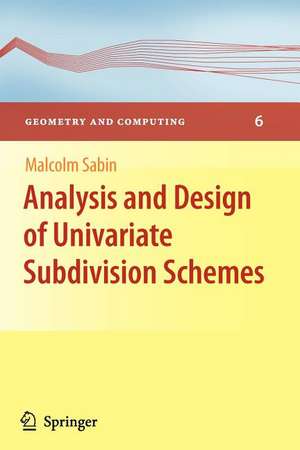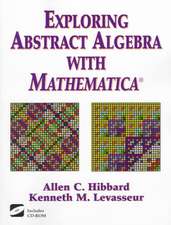Analysis and Design of Univariate Subdivision Schemes: Geometry and Computing, cartea 6
Autor Malcolm Sabinen Limba Engleză Paperback – 13 oct 2012
| Toate formatele și edițiile | Preț | Express |
|---|---|---|
| Paperback (1) | 384.48 lei 6-8 săpt. | |
| Springer Berlin, Heidelberg – 13 oct 2012 | 384.48 lei 6-8 săpt. | |
| Hardback (1) | 389.11 lei 6-8 săpt. | |
| Springer Berlin, Heidelberg – 25 aug 2010 | 389.11 lei 6-8 săpt. |
Preț: 384.48 lei
Nou
Puncte Express: 577
Preț estimativ în valută:
73.57€ • 80.17$ • 61.99£
73.57€ • 80.17$ • 61.99£
Carte tipărită la comandă
Livrare economică 23 aprilie-07 mai
Preluare comenzi: 021 569.72.76
Specificații
ISBN-13: 9783642264498
ISBN-10: 3642264492
Pagini: 232
Ilustrații: XIV, 218 p. 68 illus.
Dimensiuni: 155 x 235 x 12 mm
Greutate: 0.33 kg
Ediția:2010
Editura: Springer Berlin, Heidelberg
Colecția Springer
Seria Geometry and Computing
Locul publicării:Berlin, Heidelberg, Germany
ISBN-10: 3642264492
Pagini: 232
Ilustrații: XIV, 218 p. 68 illus.
Dimensiuni: 155 x 235 x 12 mm
Greutate: 0.33 kg
Ediția:2010
Editura: Springer Berlin, Heidelberg
Colecția Springer
Seria Geometry and Computing
Locul publicării:Berlin, Heidelberg, Germany
Public țintă
GraduateCuprins
Prependices.- Functions and Curves.- Differences.- B-Splines.- Eigenfactorisation.- Enclosures.- Hölder Continuity.- Matrix Norms.- Joint Spectral Radius.- Radix Notation.- z-transforms.- Dramatis Personae.- An introduction to some regularly-appearing characters.- Analyses.- Support.- Enclosure.- Continuity 1 - at Support Ends.- Continuity 2 - Eigenanalysis.- Continuity 3 - Difference Schemes.- Continuity 4 - Difference Eigenanalysis.- Continuity 5 - the Joint Spectral Radius.- What Converges ?.- Reproduction of Polynomials.- Artifacts.- Normalisation of Schemes.- Summary of Analysis Results.- Design.- The Design Space.- Linear Subspaces of the Design Space.- Non-linear Conditions.- Non-Stationary Schemes.- Geometry Sensitive Schemes.- Implementation.- Making Polygons.- Rendering.- Interrogation.- End Conditions.- Modifying the Original Polygon.- Appendices.- Proofs.- Historical Notes.- Solutions to Exercises.- Coda.
Recenzii
From the reviews:
“The analysis and design of subdivision schemes, by Malcolm Sabin, provides a practical approach to subdivision curve schemes based on the state of the subject mainly from the years 1972–2010 … . The bibliography includes a fairly comprehensive list of references sorted by year of publication. … It is appropriate for the computer science student wishing to learn about the subject, and can whet the appetite of the more mathematically inclined reader who is interested in further investigation of the subject.” (Scott N. Kersey, Mathematical Reviews, Issue 2011 j)
“The analysis and design of subdivision schemes, by Malcolm Sabin, provides a practical approach to subdivision curve schemes based on the state of the subject mainly from the years 1972–2010 … . The bibliography includes a fairly comprehensive list of references sorted by year of publication. … It is appropriate for the computer science student wishing to learn about the subject, and can whet the appetite of the more mathematically inclined reader who is interested in further investigation of the subject.” (Scott N. Kersey, Mathematical Reviews, Issue 2011 j)
Notă biografică
The author has spent his professional life on the numerical representation of shape.
Textul de pe ultima copertă
This book covers the theory of subdivision curves in detail, which is a prerequisite for that of subdivision surfaces. The book reports on the currently known ways of analysing a subdivision scheme (i.e. measuring criteria which might be important for the application of a scheme to a given context). It then goes on to consider how those analyses can be used in reverse to design a scheme best matching the particular criteria for a given application.The book is presented in an accessible fashion, even for those whose mathematics is a tool to be used, not a way of life. It should provide the reader with a full and deep understanding of the state-of-the-art in subdivision analysis, and separate sections on mathematical techniques provide revision for those needing it. The book will be of great interest to those starting to do research in CAD/CAE. It will also appeal to those lecturing in this subject and industrial workers implementing these methods.The author has spent his professional life on the numerical representation of shape and his book fills a need for a book covering the fundamental ideas in the simplest possible context, that of curves.
Caracteristici
All the fundamental ideas Presented in an accessible fashion even for those whose mathematics is a tool to be used, not a way of life Separate sections on mathematical techniques providing revision for those needing it























